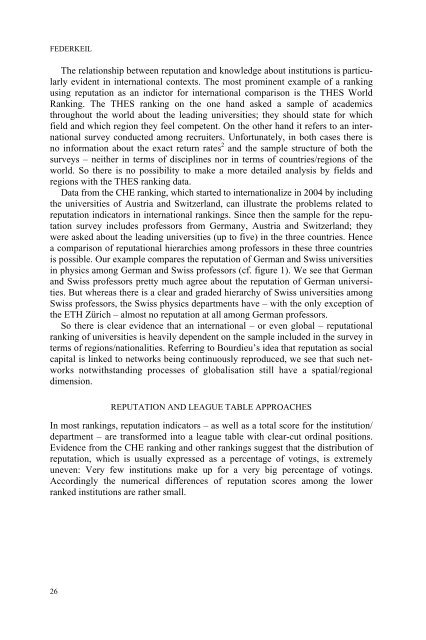University Rankings, Diversity, and the New ... - Sense Publishers
University Rankings, Diversity, and the New ... - Sense Publishers
University Rankings, Diversity, and the New ... - Sense Publishers
Create successful ePaper yourself
Turn your PDF publications into a flip-book with our unique Google optimized e-Paper software.
FEDERKEIL<br />
The relationship between reputation <strong>and</strong> knowledge about institutions is particularly<br />
evident in international contexts. The most prominent example of a ranking<br />
using reputation as an indictor for international comparison is <strong>the</strong> THES World<br />
Ranking. The THES ranking on <strong>the</strong> one h<strong>and</strong> asked a sample of academics<br />
throughout <strong>the</strong> world about <strong>the</strong> leading universities; <strong>the</strong>y should state for which<br />
field <strong>and</strong> which region <strong>the</strong>y feel competent. On <strong>the</strong> o<strong>the</strong>r h<strong>and</strong> it refers to an international<br />
survey conducted among recruiters. Unfortunately, in both cases <strong>the</strong>re is<br />
no information about <strong>the</strong> exact return rates 2 <strong>and</strong> <strong>the</strong> sample structure of both <strong>the</strong><br />
surveys – nei<strong>the</strong>r in terms of disciplines nor in terms of countries/regions of <strong>the</strong><br />
world. So <strong>the</strong>re is no possibility to make a more detailed analysis by fields <strong>and</strong><br />
regions with <strong>the</strong> THES ranking data.<br />
Data from <strong>the</strong> CHE ranking, which started to internationalize in 2004 by including<br />
<strong>the</strong> universities of Austria <strong>and</strong> Switzerl<strong>and</strong>, can illustrate <strong>the</strong> problems related to<br />
reputation indicators in international rankings. Since <strong>the</strong>n <strong>the</strong> sample for <strong>the</strong> reputation<br />
survey includes professors from Germany, Austria <strong>and</strong> Switzerl<strong>and</strong>; <strong>the</strong>y<br />
were asked about <strong>the</strong> leading universities (up to five) in <strong>the</strong> three countries. Hence<br />
a comparison of reputational hierarchies among professors in <strong>the</strong>se three countries<br />
is possible. Our example compares <strong>the</strong> reputation of German <strong>and</strong> Swiss universities<br />
in physics among German <strong>and</strong> Swiss professors (cf. figure 1). We see that German<br />
<strong>and</strong> Swiss professors pretty much agree about <strong>the</strong> reputation of German universities.<br />
But whereas <strong>the</strong>re is a clear <strong>and</strong> graded hierarchy of Swiss universities among<br />
Swiss professors, <strong>the</strong> Swiss physics departments have – with <strong>the</strong> only exception of<br />
<strong>the</strong> ETH Zürich – almost no reputation at all among German professors.<br />
So <strong>the</strong>re is clear evidence that an international – or even global – reputational<br />
ranking of universities is heavily dependent on <strong>the</strong> sample included in <strong>the</strong> survey in<br />
terms of regions/nationalities. Referring to Bourdieu’s idea that reputation as social<br />
capital is linked to networks being continuously reproduced, we see that such networks<br />
notwithst<strong>and</strong>ing processes of globalisation still have a spatial/regional<br />
dimension.<br />
REPUTATION AND LEAGUE TABLE APPROACHES<br />
In most rankings, reputation indicators – as well as a total score for <strong>the</strong> institution/<br />
department – are transformed into a league table with clear-cut ordinal positions.<br />
Evidence from <strong>the</strong> CHE ranking <strong>and</strong> o<strong>the</strong>r rankings suggest that <strong>the</strong> distribution of<br />
reputation, which is usually expressed as a percentage of votings, is extremely<br />
uneven: Very few institutions make up for a very big percentage of votings.<br />
Accordingly <strong>the</strong> numerical differences of reputation scores among <strong>the</strong> lower<br />
ranked institutions are ra<strong>the</strong>r small.<br />
26














